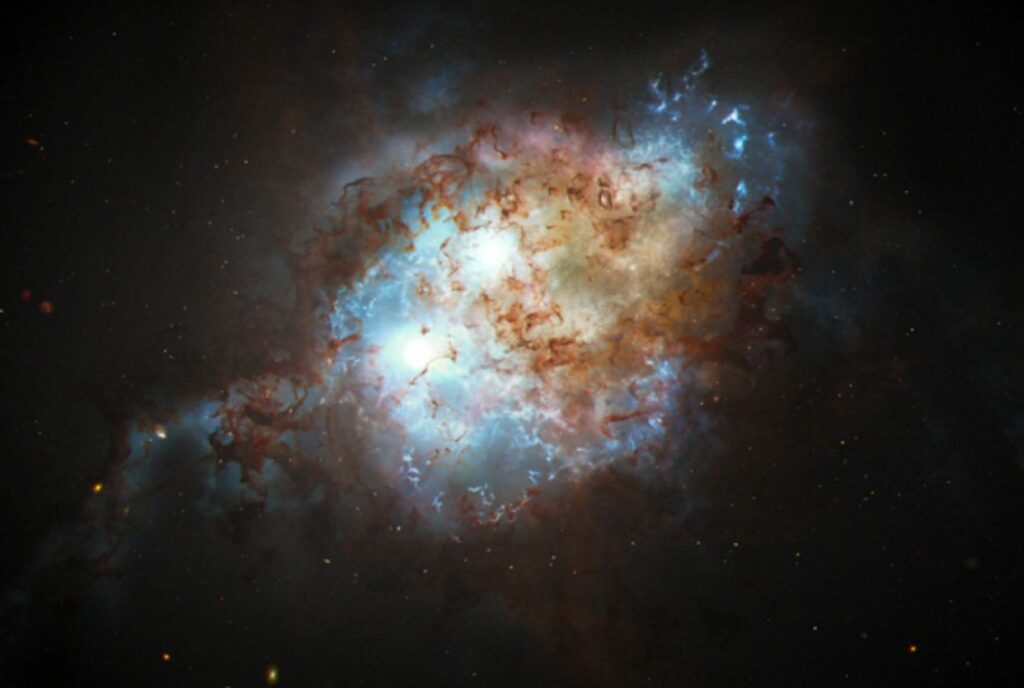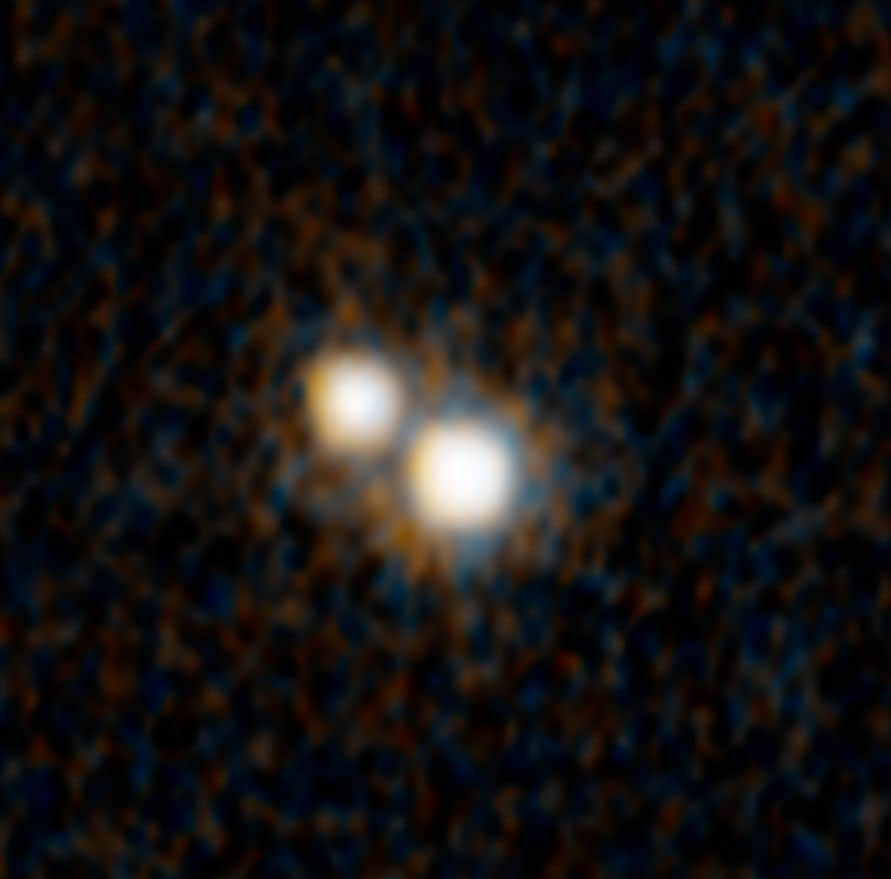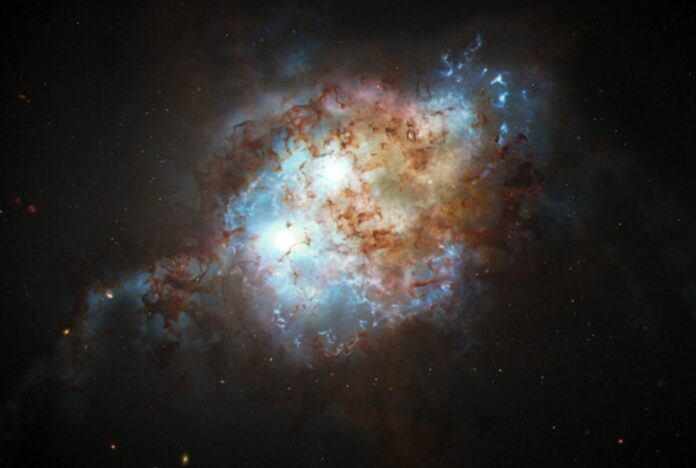Quasars are incredibly luminous objects fueled by supermassive black holes that consume gas, dust, and other matter in their vicinity, emitting powerful jets of energy.
Recently, astronomers have used NASA’s Hubble Space Telescope and other space and ground-based observatories to make an exceptional and unexpected discovery: a duo of gravitationally bound quasars, both active within two merging galaxies that existed when the universe was just 3 billion years old.
This discovery of close binary quasars is a relatively new area of research that has only emerged in the past decade or so. Thanks to the advanced capabilities of today’s observatories, astronomers can now identify cases where two quasars are both active at the same time and are located near enough to each other to eventually merge.
Mounting evidence suggests that the growth of large galaxies is primarily driven by the merger of smaller systems, resulting in increasingly larger structures. This process is thought to lead to the formation of pairs of supermassive black holes within the merging galaxies.
Understanding the population of precursor black holes will ultimately shed light on the emergence of supermassive black holes in the early universe and provide insights into the frequency of these mergers, according to lead author Yu-Ching Chen.
“We’re starting to unveil this tip of the iceberg of the early binary quasar population,” remarks Xin Liu of the University of Illinois at Urbana-Champaign.
“And now we have a method to identify double quasars that are separated by less than the size of a single galaxy.”

Discovering the rare and remarkable pair of gravitationally bound quasars required a painstaking search, made possible by the collaborative efforts of several observatories. NASA’s Hubble Space Telescope and the W.M. Keck Observatories in Hawaii provided critical data, while the International Gemini Observatory, NSF’s Karl G. Jansky Very Large Array, and NASA’s Chandra X-ray Observatory contributed multi-wavelength observations that helped scientists better understand the quasars. Additionally, ESA’s Gaia space observatory played a vital role in initially identifying this double quasar.
“Hubble’s sensitivity and resolution provided pictures that allow us to rule out other possibilities for what we are seeing,” adds Chen.
The Hubble images provided conclusive evidence that the object is a true pair of supermassive black holes, rather than two images of the same quasar generated by a gravitational lens in the foreground. Furthermore, the Hubble data revealed a tidal feature resulting from the merger of two galaxies, in which the gravitational forces distorted the galaxies’ shapes and generated two tails of stars.
While Hubble’s impressive resolution alone is not sufficient for detecting dual quasars, researchers have developed an innovative method that leverages data from the Gaia space observatory to identify potential candidates. Launched in 2013, Gaia can accurately measure the positions, distances, and motions of celestial objects in close proximity. Moreover, Gaia’s vast database is also useful for exploring the distant universe. Researchers can search for quasars that appear to move in the same way as nearby stars, even though they are actually much further away. Although the quasars appear as a single object in the Gaia data due to their proximity, the observatory can detect subtle jiggles that mimic an apparent shift in position.
Contrary to appearances, the dual quasars are not physically moving through space in a measurable way. Rather, the apparent jiggle in their position could be attributed to the random fluctuations in light emission as each member of the quasar pair varies in brightness over days to months due to its black hole’s feeding schedule. The alternating brightness between the quasar pair creates a visual effect similar to that of a railroad crossing signal observed from a distance. The flashing lights on either side of the stationary signal give the impression of a “jiggling” motion.

One of the challenges in identifying a binary quasar is that the gravitational influence of a foreground galaxy could distort the light from a distant quasar, causing it to appear as two separate sources. To eliminate this possibility, the team used the Keck telescope to confirm that there was no lensing galaxy between Earth and the suspected binary quasar.
Because Hubble is capable of peering into the distant past, the double quasar that it observed no longer exists. Over the course of the intervening 10 billion years, the galaxies that hosted the quasars are likely to have settled into a giant elliptical galaxy, similar to those observed in the present-day universe. The quasars themselves have likely merged to form a colossal supermassive black hole at the galaxy’s center. For instance, the nearby giant elliptical galaxy M87 is known to have a monstrous black hole weighing 6.5 billion times the mass of the Sun, which may have grown from one or more galaxy mergers over billions of years.
The forthcoming NASA Nancy Grace Roman Space Telescope, with its comparable visual acuity to that of Hubble, is poised to revolutionize the search for binary quasars. While Hubble has been employed to painstakingly gather data for individual targets, the Roman telescope’s wide-angle infrared view of the cosmos is 200 times larger than that of Hubble. As such, it is an ideal instrument for surveying large swaths of the universe for dual quasar candidates.
“A lot of quasars out there could be binary systems. The Roman telescope can do huge improvements in this research area,” adds Liu.
The findings of the study were published today in the journal Nature.
Image Credit: NASA, ESA, Yu-Ching Chen (UIUC), Hsiang-Chih Hwang (IAS), Nadia Zakamska (JHU), Yue Shen (UIUC)
